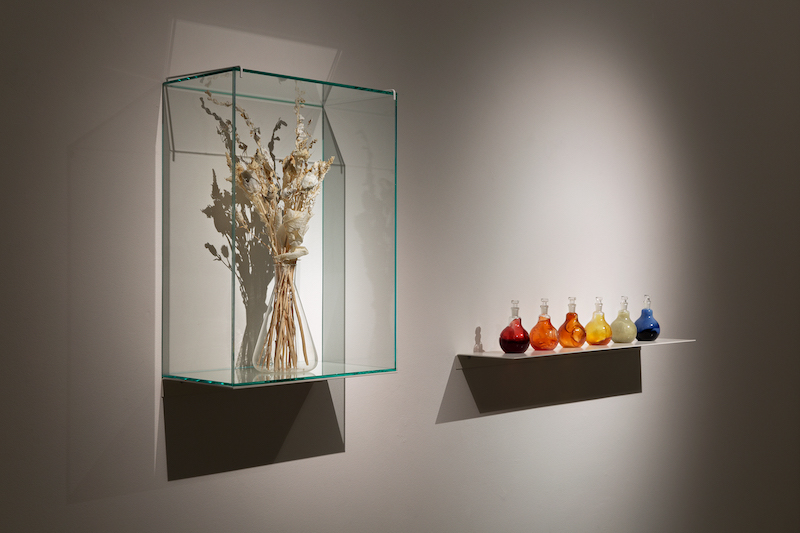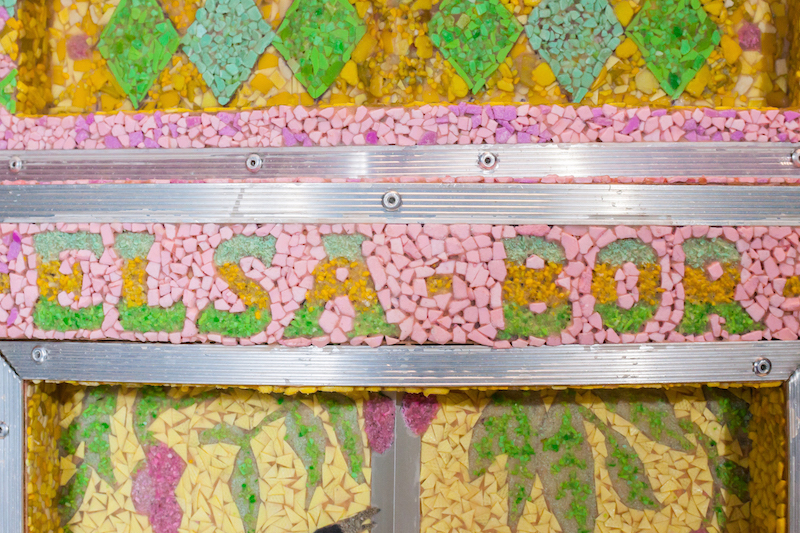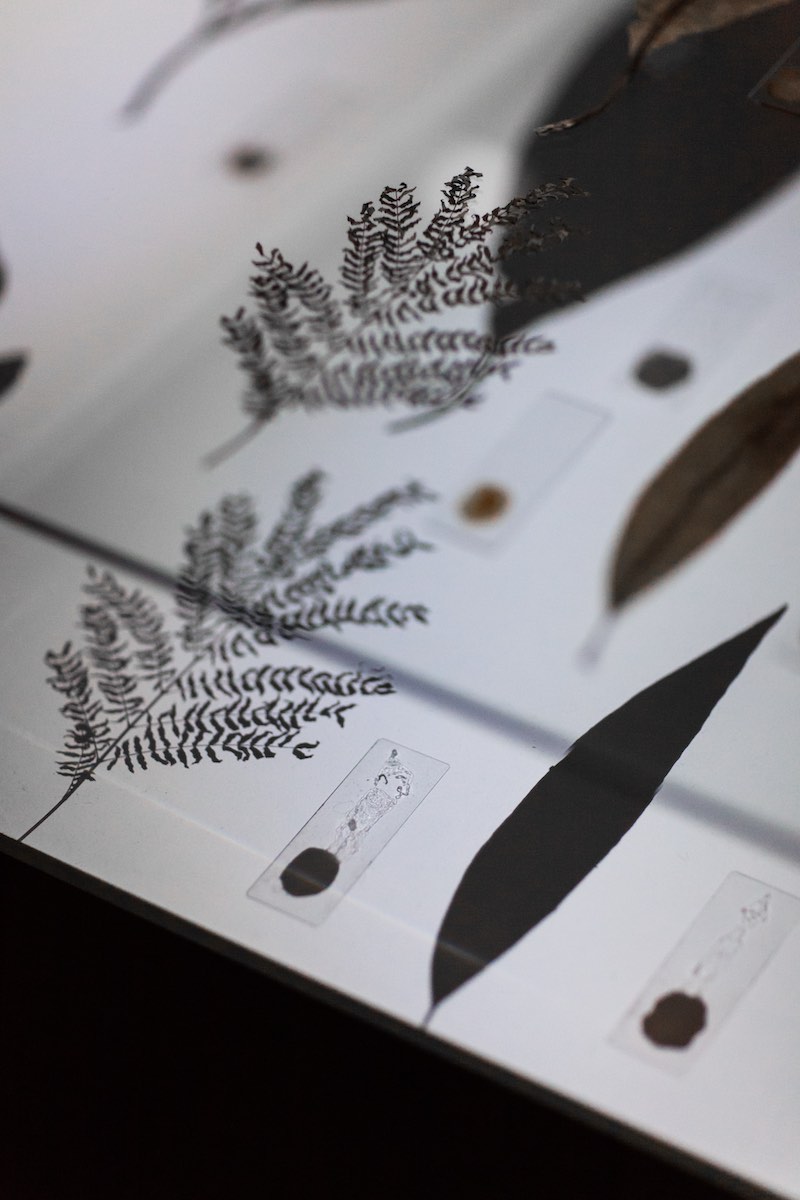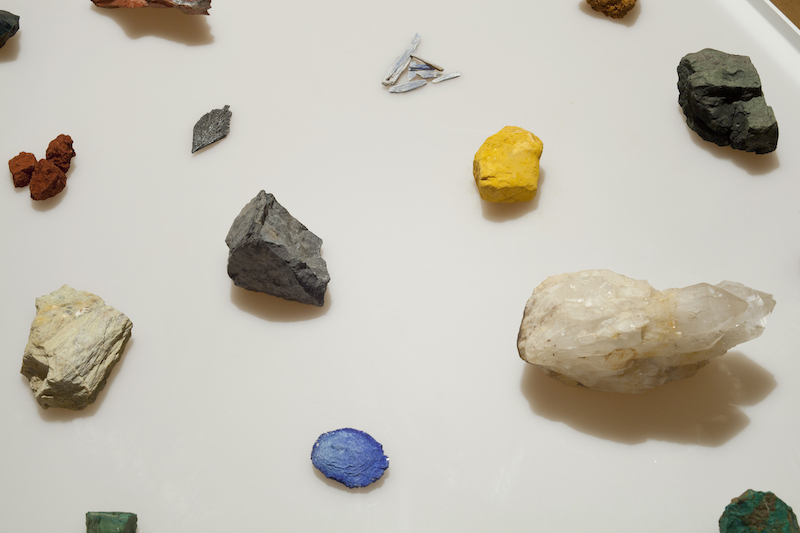Elsa Salonen, "Stories Told by Stones (The Narrators)," mineral stones, earths, pigments ground from them, laboratory glasses, 2018 © the artist
Fossils are older than we can even imagine sequences of time. Imagine they could speak. They store historical information about our planet, which seems to fall apart in this very moment, in the age of the anthropocene – the human era. This current epoch is defined by the enormous impact human beings have on the earth's ecosystems and its geology. In light of the dystopian future this era promises, there seem to be only two sets of reactions left for us: resignation or activism. The Finnish, Berlin-based artist Elsa Salonen chose the latter and her activism – which is an essential part of her artistic research – involves giving the earth and all its natural materials a voice to speak. She distills colours from flowers, and extracts pigments from stones, she uses bones, earth, meteorite dust, seawater from places all over the planet, to reveal something about the knowledge these materials store. In our interview, which we initially commenced in 2015 and continued in 2019, Elsa told me how she makes traditions of animism and processes of alchemy productive for her artistic practice.
Anna-Lena Werner: Elsa, since several years your work addresses aspects of the anthropocene. How do you position your practice in this discourse?
Elsa Salonen: Although it may be depressing to research about the anthropocene, I have a very positive approach to it. My way of dealing with this huge subject is through animism. We have many healthy traditions in our relationship with nature, which I try to revitalise. Art is a good tool for that, because I can freely choose my point of view. Not only in Finland, where I come from, there are traditional nature religions and people who see nonhuman creatures, such as stones, trees or lakes, as equal beings with their own consciousness.
ALW: How have Finnish traditions acknowledging nature played into your practice?
ES: They probably influence my general approach to nature and non-humanity, and my approach to animism. The term has actually also been connoted negatively, as colonialist traditions manifested a disrespect of indigenous people who often believe the spirituality of non-human beings. The English author Graham Harvey has been a helpful source for me, as he re-invented the discourse of animism, arguing that its knowledge or wisdom is required now in the time of climate crisis. Some works of mine relate to Finland quite directly, but most address phenomena of animism globally.
ALW: Is there a particular or personal reason that brought you to work with animism?
ES: When I was about six years old, there was a particular spot with a big rock in the nearby forest close to our home. It used to be my safe spot – where I went when I felt confused or sad. It gave me comfort and I began to feel a strong connection with this stone and the place. When I first discovered texts about animism later in my life, I was happy to read words describing the habits I had as a kid.


Above: Elsa Salonen, "Stories Told by Stones (Late Paleozoic Era)," stone and earth pigments (especially alba albula, yellow ochre, quartz, thulite, red ochre) and alum crystal on glass; below: "Stories Told by Stones (Lepidodendron)," stone and earth pigments (especially lapis lazuli, quartz, sodalite, alba albula, malachite) and alum crystal on glass; both 2018 © the artist
ALW: A recent exhibition you had this year at Schwartzsche Villa in Berlin-Stegliz was titled "Stories Told by Stones" (2019) – is it linked to these childhood memories of yours?
ES: It was partly related to it. Throughout the last years I worked with several natural materials, from meteorite dust to volcanic ash, from flowers and medicinal plants to fox bones, only not with stones. In the exhibition you mention, there were many paintings painted with pigments extracted from mineral stones. Most of those minerals are a lot older than human kind, they can give us information. Geologists have discovered most of the knowledge we have about the planet earth through the research of stones and fossils. Through the animist point of view, learning from stones is to communicate with them, like we would do with a grandmother who tells us about the past. What would stones tell us if we had a common language? Connecting the scientific and spiritual knowledge of stones was at the core of this exhibition. Both sides express their wisdom, only in very different ways.

Elsa Salonen, Flower Painting, the Act of Immortalising a bleached bouquet and its distilled colours, isomalt, glass; 2017 © the artist
ALW: You often change the solid consistency of materials, such as grinding and cooking them, or extracting pigments. Why do you bring them through this journey of different forms?
ES: I had a turning point in my work about seven years ago. I used to paint with oil paint on Plexiglas, eager to express the fading of colours when beings die. It always felt unsatisfying simply illustrating this process. I took a break and read alchemic texts, which led me to experiment with the materials directly. Experimenting also meant boiling flowers and to burn bones in order to extract their colours. The first natural material I extracted colour from was a flower from the garden of the residency program Künstlerhaus Schloß Wiepersdorf in the south of Berlin. Usually I do these processes myself, but for the last exhibition I needed a lot of different shades from the mineral stones. The family-run pigment company Kremer in the South of Germany helped me with the colours, as they have a lot of experience and the right technical equipment.
ALW: Did you find the stones and send them to the factory?
ES: No, most of the stones and pigments used for this exhibition came from the family's own collection, which they have built for decades and gathered from all over the world. Other materials I collected myself, such as ochre from Colombia, which is more like a soft earth that I can grind myself.
ALW: You have been doing many residencies lately, such as you just mentioned, in Colombia. What project have you been working on there?
ES: Prior to the trip I only knew that I wanted to work as usual, collecting local, natural material and turn it into colour. When I arrived in Cartagena, located at the Northern coast of Colombia, I realised that the most visible thing in nature is plastic rubbish. It made me wonder if I really wanted to use trash in my work and thus brought me to the question of where to draw the line between what is natural and what is not. I ended up using the plastic waste from the beaches and their pigments in reference to a tradition called "Picó", typical for northern Colombia. "Picó" refers to the Afro-Colombian tradition of a sound system set up with colourful, personalised speakers that are placed on the streets to play loud dance music. Extracting the colours from plastic allowed me to generate neon tones, which I cannot produce with natural material. For my project I built an installation with my "Picó" and decorated it with lots of found pieces. A local music group, called "Electromagnético", created a song for the speaker. The installation is called "La voz del paisaje" (2018), which means "the voice of the landscape". It's about reclaiming the rights of nature.




Elsa Salonen, "La voz del paisaje," plastic waste and other objects collected on the beaches of Cartagena - Colombia, glass, picò loudspeaker with audio by the group Electromagnético, 2018 © the artist
ALW: The question of where to draw a line between what is natural and what is not is quite ambivalent, especially since plastic waste is increasingly becoming a part of us and our bodies. If you look at it from an animist perspective, how can you communicate with plastic material?
ES: I suppose it is good not be too romantic about nature and about where it ends. For example, if a tree is turned into a wooden table. Personally, I feel that natural material looses a bit of its consciousness during each transformation process. Perhaps there is some kind of consciousness, even if it's only on an atomic level. No one really knows, just as no one knows where the consciousness of humans is really located. If there is a consciousness in plastic, it has already gone through a long journey of transformations.
ALW: Prior to your "Picó" project, you have participated in another residency in Colombia, called Lugar a Dudas in Cali...
ES: ...Yes, there I worked with medicinal plants that are used against colds, stomach aches and many other sicknesses. I was amazed about the wisdom of those plants, enabling them to heal human diseases. I played with this idea that plants may have knowledge of the human body through the infinite circulation of consciousness in atoms: when something dies, plants and animals may grow out of it and this process has continued since the first day of the earth. Everything is connected.
ALW: In your work you distinctively withdraw hierarchies and instead treat every being or material on the same level. How has this been when you worked with bones?
ES: One project of mine, called "Eighty Modest Statements about the Impossibility of Death" (2013), I did with fox bones that I burned and turned into pigments. From the colour I made 80 paintings of plants. This project was linked to the idea that death is impossible, as we will be recycled infinitely as material. Plants will grow from a dead fox, new life will appear and the material will remain in some form. Perhaps it was also a way for me to process the death of a good friend of mine, who had passed away just before this project.


Elsa Salonen, "Eighty Modest Statements about the Impossibility of Death," ash from burned fox bones, plastic, fox skull, brass bowls, 2013 © the artist
ALW: When you turn pigments into motifs on paintings, you add a new layer, as in your own creative consciousness, to the existing material...
ES: ... I actually consider it a sort of collaboration. What I add is linked to the wisdom that the material has –– the 300 Million year old mineral stones, the bones of a dead animal, the plants. Motifs and colours are linked to their knowledge. It's their rules together with my contribution and movements.


Elsa Salonen, "We Are All Made of Stardust (Northern Hemisphere)," detail; stone and iron meteorite dust on glass, 2017 © the artist
ALW: The relation between motif and pigment must have been different in the "Stories Told by Stones" exhibition, since you didn't collect most of the mineral stones yourself.
ES: I think my works could be divided into two groups. The ones that speak about more universal themes are created with pigments that I haven’t gathered myself from the nature, such as the meteorite paintings or the cut flower pieces. The second group of works, often produced in art residencies, deal with more local themes, such as “Buni Buana (Hidden World)” (2014-2015) from Indonesia or the works I made in Colombia. “Stories Told by Stones” belongs into the first category. For the exhibition I painted extinct plant species on glass that existed in the tropical forests of the Carboniferous Period, which was present around 300 million years ago in the northern hemisphere. The stones that I used as colour pigments for the paintings existed already back then - unlike humans.




Elsa Salonen, "Buni Buana (Hidden World)", natural elements collected from Indonesia and colours distilled or ground from them, glass, transparent paint, lights, 2015 © the artist
ALW: What are you working on right now?
ES: At the moment I am preparing work for a group exhibition at the Nordic Embassies in Berlin about the Baltic Sea. My installation will be dedicated to our ancient sea sprites. In Finland I will be collecting material, such as seaweed, seawater and stones. With each new material I use, I also need to invent the technique again.

